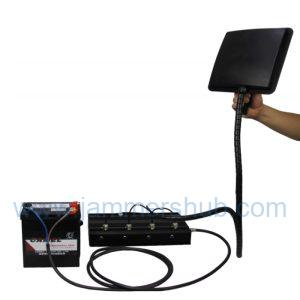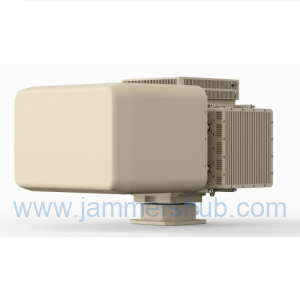This fixed active UAV RF signal detector employs advanced stereo active radar technology aimed specifically at detecting – ow, small and slow – /strong> targets that traditional radar systems struggle to identify – such as drones characterized by their minimal size, slow speeds, and low-altitude flight.
Featuring high-sensitivity built-in antennas and intelligent signal filtering, it significantly mitigates background noise and electromagnetic interference, enhancing detection and identification precision.
Its sophisticated tracking radar defense system can concurrently identify as many as 50 targets within a span of 5 kilometers, while capturing and processing multi-dimensional data including distance, azimuth, elevation, and speed in real time, creating a detailed three-dimensional motion profile for low-altitude moving entities.
The system outputs target trajectory data through established interfaces, enabling optimal guidance for electro-optical and command and control systems, thereby offering accurate direction for tracking and interception. It also reserves input interfaces for remote control and network integration.
The T-PD3000 is equipped with continuous tracking capabilities, which allow for real-time updates on the position and trajectory of targets, facilitating rapid responses to any target alterations.
The automatic calibration feature dynamically adjusts according to changing environments, ensuring the detection results remain consistently accurate.
The T-PD3000 supports a visual confirmation range of up to 1.5 kilometers, ensuring reliable target identification. This is further enhanced by the multi-sensor fusion of the radar system, which provides accurate visual feedback during detection, assisting users in making secondary confirmations and minimizing false alarms.
The antenna cover is specifically designed to shield internal components from adverse conditions, being waterproof, dustproof, and shockproof, thereby ensuring dependable operation in extreme environments.
Featuring an open architecture design that is highly compatible and scalable, it can be seamlessly integrated with various security systems. Users are able to develop comprehensive monitoring solutions (like video surveillance and automated defense systems) tailored to their distinct requirements.
To not only monitor signals but also effectively neutralize unauthorized drones invading your private domain, it is advisable to utilize the anti-drone jamming device D-US-01, ensuring that airborne intruders are deterred from entering secured areas.
Equipment Highlights:
1. Lightweight structure for easy setup
2. Continuous tracking of trajectories, real-time updates
3. Automatic north calibration for directional accuracy
4. 24/7 all-weather surveillance
5. High-resolution 360?? coverage with precision
6. Visual recognition capability extending to 1.5 kilometers
7. Stereoscopic active detection integrated multi-sensor framework
8. Open architecture compatible with other security and display systems
9. Operates on the Windows operating system, with an integrated multi-sensor display featuring a – lick to zoom – to trigger deterrence
Detection Range:
| Channel | Power |
| GPS L1: 1565-1586MHz | 10W |
| WiFi 5.2G: 5725-5850MHz | 20W |
| WiFi 2.4G: 2400-2484MHz | 20W |
| Customizable: 430-440MHz(10W); 900-930MHz(20W) | |
Specifications of Drone RF Signal Detector:
* Modulation method: FMCW (Frequency Modulated Continuous Wave)
* Frequency band: K band (24GHz, in line with FCC and ETSI standards)
* Transmitting power consumption: 10W
* Bandwidth: 40MHz
* Scanning approach: Mechanical scanning
* Scanning velocity: 10 rpm (60??/s) & 20 rpm (120??/s)
* Detection reach: 250m-3km (RCS=0.01m2)
* Ranging precision: ??2m (RCS=0.01m2)
* Horizontal coverage angle: 0??-360??
* Pitch angle range: 0??-90?? (adjustable)
* Pitch beam: 30??
* Detection velocity: 1.4-30m/s
* Power supply voltage: 100-240V AC (50/60Hz)
* Equipment electrical consumption: ??00W
* Protection rating: IP65
* Operating temperature: -40 – 55??br>* Communication interface: RJ45







Reviews
There are no reviews yet.